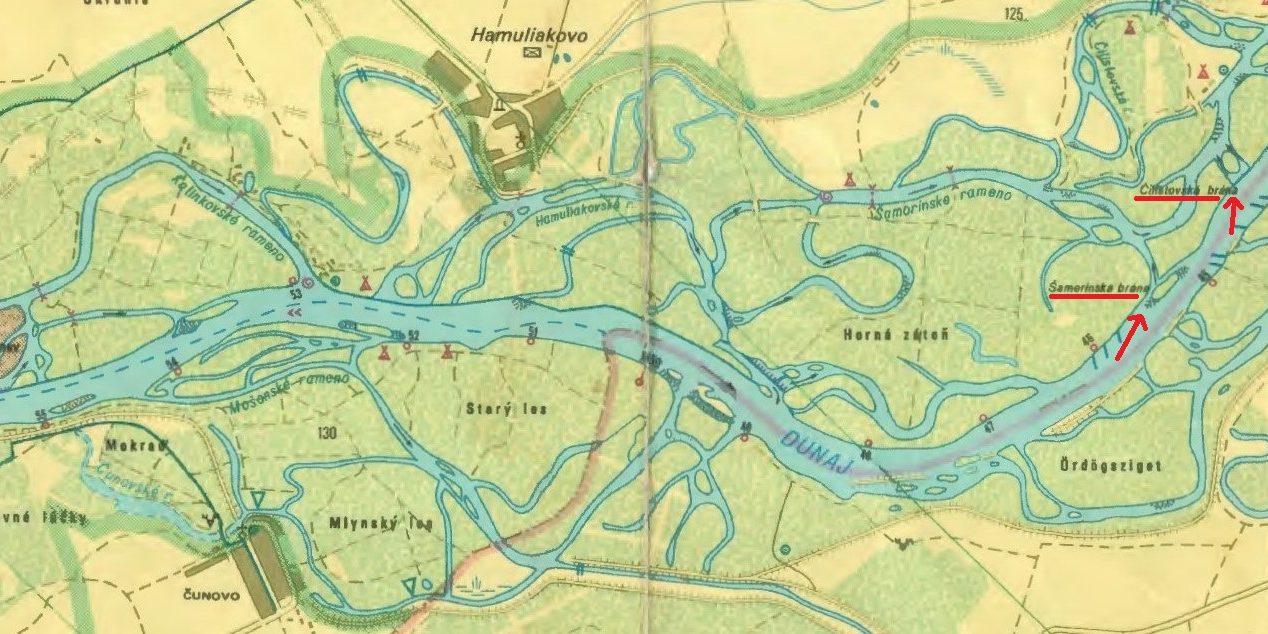Danube Gates – gateways to the world of river branches
Those who knew the Danube and its branch system before the construction of the Gabčíkovo waterworks, knew what the so-called Danube gates are and where they are located. Of course, they were not real gates, but just a name for the connection of the main flow of the Danube and its branch systems.
Danube water full of oxygen flowed through the gates into a branched system of arms, with larger flows gravel also entered the arms through these paths. They were also the entrance gates for fish, which found their spawning grounds in the branch system formed by a truly diverse mosaic of aquatic habitats. Most of the original Danube species of fish used to spawn in the side branches of the river. Why? There was a weaker current in places, but still strong enough to keep the water well oxygenated, a huge supply of food for the herbivorous species and the table just set for the predators. In the branch system, unlike the main stream, there were always enough shelters where both young and adult fish found a safe haven (root systems of riparian vegetation, trees fallen into the water, flooded parts of forests and meadows, etc.).
In the old boating map (published before the construction of the Gabčíkovo water works), the individual gates are marked, even though some of them no longer fulfilled their function, as they were partially or fully filled in to adjust the flow for navigation. Of course, boaters knew them and used them a lot. It was through these places that one could swim into another – extremely rich world of the inland Danube delta and return back to the main riverbed.
On the map, you can find the Čilistovská gate, the Šamorín gate, the Šulianska gate and the Bodícka gate. Boaters may remember others.
The last open gate to the side arm system was the Šulianska Gate in the 1970s. The branch system in the area of the Šulianske side arm was wonderful – a lot of gravel, a wide flowing main branch, but also narrow winding branches, blind branches with stagnant water and extensive wetlands – periodically flooded meadows and floodplain forests. Part of the islands that the river branch system created were pastures, the animals modeled the landscape, the appearance of which was determined by water. At the time of higher flows, there were full branches and wetlands, flooded meadows and forests. On the other hand, during lower flows, white exposed gravel benches – yes, right in the branch system and exactly where you can find mostly mud today – sorry, technically fine sediments.
How are the Danube gates today?
Today, unfortunately, they are all “closed” and you would not even find them properly in the field. And even if they were open, they would not bring any oxygenated, flowing or life-giving Danube water, and certainly not gravel. The branch system between the villages of Dobrohošť and Sap (a total of approximately 3,000 ha of territory) is isolated from the Danube. Sadly, little water flows through the old channel – 250 m3 in winter / 400 m3 in summer (for comparison, the average annual flow in the Danube is approximately 2,000 m3 and it used to flow here). Therefore, today the Old Danube bed is 3-4 m deeper than the branch system. New gravel does not come, only fine sediments, which after settling form mud in the branches. Fish cannot get from the Danube to the branch system during migration, and to prevent the entire area from drying out, linear weirs were built that divided the branch system into a system of pools with mostly stagnant water.
The consequences can occur to almost everyone, and they are definitely not positive.
The branch system, which is not properly flushed, and only fine sediments arrive there, gradually becomes clogged, which reduces the important capacity of the territory for the transfer of flood waves. In the shoulders, the bottom is no longer gravel, but muddy. Water that does not flow does not have enough oxygen, and as the temperature of the water increases, there is even less of it in the summer. Lack of oxygen goes hand in hand with putrefactive processes.
We can do nothing, watch, watch the gradual extinction, lament after each flood that the water was higher again and not believe the older people when they talk about the former beauty and immense richness of the environment. However, complaining, grumbling and shouting will not change anything.
It is therefore necessary to make the most of the existing state and work on restoring what can still be restored.
This is precisely why we strive for practical nature protection – to connect experts and enthusiasts who are willing to devote themselves to this topic. Alpha and Omega in this effort are the projects and cooperation of experts from state organizations such as Water Research Institute, State Nature Conservancy, Water Management Construction, Slovak Water Management Company. Together, we want more water and therefore more oxygen to flow into the branch system, so that flowing sections with a gravel bottom can be created wherever possible.
So that the weirs in the system (and there are 30 of them in total) are rebuilt in a way that allows the system to be flushed. So that the artificially isolated and dried wetlands have a renewed water regime and, thanks to the water, they were again areas that are less overgrown with dense vegetation, and therefore also have a large capacity for water, which we will appreciate at the time when century-old water will flow through the Danube again. Or in normal years, at least during the period of simulated floods, which we need abundant and regular.
Both us and this precious territory.
We are gradually modifying and restoring the Danube arms in the inland Danube delta in this way. We are currently working on the restoration of the lower Vojčianske side arm. The Šulianske arm recently underwent such modifications.







